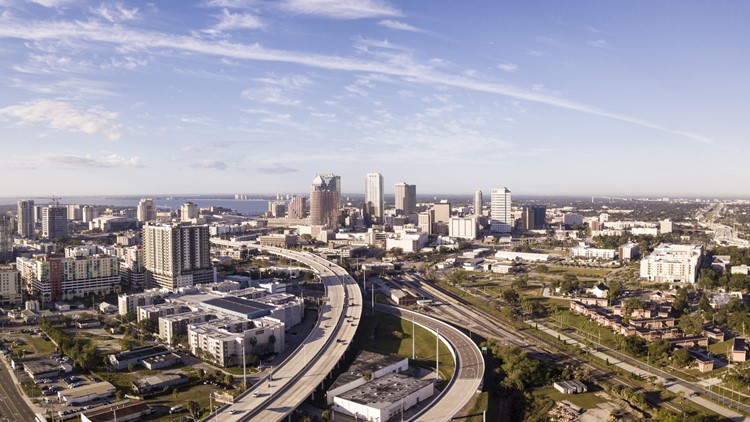TAMPA, Fla. — Back in March 2020, the Florida Department of Environmental Protection announced that the state had finally met National Ambient Air Quality Standards (NAAQS). For years, DEP said it had worked with the Environmental Protection Agency to reduce emissions and improve air quality in the Sunshine State.
What that meant was the state was able to keep six pollutants in check: carbon monoxide, lead, nitrogen dioxide, ozone, particulate matter and sulfur dioxide. It was the cleanest air Florida had on record, according to DEP.
But, just one year later, the American Lung Association (ALA) published its "State of the Air" report which tracks people's exposure to unhealthy levels of ozone and particle pollution over a three-year period. In it, Hillsborough County was the only area to receive an "F" for its ozone levels.
So, why is that?
Well, according to ALA Executive Director Steven Riddle, the grade comes from the double-digit days the county spent in the orange. A code orange means the amount of pollution in the air has caused it to become unhealthy for sensitive groups, like children, older adults and people with heart or lung disease to breathe. It's just one tick below a code red, which impacts everyone.
According to the report, Hillsborough County had 12 orange days.
But, what's causing the ozone pollution?
Riddle says it's caused by the reaction in the atmosphere when nitrous oxide from cars and trucks as well as from power plants and industrial sources is in the presence of sunlight.
That's why Dr. Amy Stuart, a professor at the University of South Florida who specializes in air quality, says it's no surprise a commuter heavy county like Hillsborough would experience high levels of ozone pollution.
"Our roadway network is all cars. We don't have other options," Stuart says.
"There's a lot of vehicle miles. We travel – meaning every person travels a lot. Our area is rather sprawling. And, with all that comes a lot of traffic and a lot of emissions."
But, why aren't other Florida counties with large metropolitan cities like Miami-Dade (which received a "C") and Duval (which received a "B") not seeing the same level of pollution?
Dr. Stuart says it's all about location.
"Ozone forms in the atmosphere, so it's a combination of emissions and the meteorology," Stuart says.
Since ozone is a regional pollutant, particles can hover over large areas. But, strong winds can help it to scatter.
In the case of Hillsborough County, the region receives strong winds from the Gulf of Mexico, as well as the Bay, shunting those particles over land. Also, another scenario is when the county sees winds from the east or southeast, this flow can bring over pollutants from cities on the Atlantic Coast.
10 Tampa Bay meteorologist Natalie Ferrari also adds that it's important to take our warming climate into account.
"A contributing factor behind Tampa Bay's problematic ozone levels may be attributed to our warmer temperatures," Ferrari says.
"Ozone needs heat and sunlight to chemically react to gases in our atmosphere with organic compounds that can typically be found in vehicle and industrial exhaust, factors that impact the area nearly year-round. Then when you mix in record-breaking heat each year, climate change makes this problem worse."
The vastness of ozone pollution also makes it difficult to narrow down which specific areas are feeling its harmful effects worse than others.
A study by the University of Washington found that between 1990 and 2010, communities of color across the nation were disproportionately exposed to harmful pollutants. One of the major findings from the study was that more than a decade ago, Hispanic Americans and Asian Americans faced the highest exposure to nitrous oxide. The disparity continued when income level was accounted for.
Dr. Stuart says there's no definitive study that finds the same results on a local level, but adds that communities of color in Hillsborough County tend to reside near highways where ozone pollution is worse.
Both Riddle and Stuart say climate change will most likely make ozone pollution a persistent issue but offer some possible solutions to ease its impacts.
Riddle suggests carpooling to reduce the number of cars on the roadways, thus reducing emissions. Dr. Stuart though says the solution is in how a community is designed.
"Things that could change would be changing our urban design so that we don't all have to drive so much to get to work, to get to school, to do our activities throughout the day."
DEP says, while Hillsborough is experiencing more high-level ozone days than other Florida counties, the region's air quality is improving with the number of ozone days decreasing over time. In fact, according to DEP, EPA data shows Hillsborough's air quality is in the top 14 percent of cleanest counties nationwide behind all other Florida counties.
The agency also adds that it's important to note that the American Lung Association's report looks at high ozone days over the course of three years. The county and state, in general, are not in violation of any federally established air quality standards.



